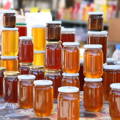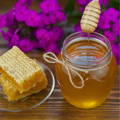
From Flower to Table: How Honey is Created
Honey is a remarkable creation produced by bees. It brings a delightful sweetness to our lives and is crafted through a fascinating process. Explore the enchanting journey of honey-making, from the flower to your table.
FUN FACT: A beehive can produce anywhere from 30 to 100 pounds of honey a year.
Subscribe
To join our mailing list and never miss an update!
IT ALL STARTS AT THE FLOWER
Honey production begins with the creation of nectar within the flowering plants themselves. This nectar, a sugary liquid, is secreted by specialized glands called nectaries. While sucrose (commonly known as sugar) forms the primary component of nectar, it also contains smaller quantities of fructose and glucose.
The location of nectaries on flowers varies from one plant species to another, and the amount of nectar they produce can be influenced by factors such as the time of day and environmental conditions.
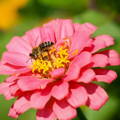
Interestingly, honeybees, butterflies, and other flying insects play an essential role in this process, forming a symbiotic relationship with the flowering plants. As these insects visit the flowers to collect nectar, they inadvertently aid in pollination.
The plants, in turn, show their gratitude by producing nectar, enticing these valuable pollinators to visit more flowers and spread their pollen, thereby facilitating reproduction. It's a remarkable example of the intricate balance and interdependence found in nature.
One of the remarkable features of honey is its tremendous diversity in color, flavor, and aroma. The variations in honey are largely influenced by the types of flowers from which the bees collect nectar. For instance, honey sourced from orange blossom nectar might exhibit a light hue and carry a citrusy flavor, while honey derived from avocado or wildflowers could boast a rich, dark amber color and a robust, earthy taste.
Once a honeybee discovers a source of nectar, it uses its specialized proboscis to extract the sugary liquid from the flower's nectary. The bee then stores the nectar in its honey sac, a special pouch-like structure within its body, for the journey back to the hive. As the bee returns to the hive, it shares its discovery with its fellow worker bees, who head out to join in the collection efforts.
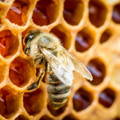
tHE HIVE IS WHERE THE MAGIC HAPPENS
Upon arriving back at the hive, the honeybee regurgitates the collected nectar into the cells of the honeycomb. Enzymes present in the bee's digestive system mix with the nectar, initiating the process of breaking down complex sugars into simpler sugars. This transformation is a crucial step in the creation of honey.
The honeycomb's unique structure, with its hexagonal cells, allows for the most efficient storage of honey. To further convert the nectar into honey, the bees fan their wings tirelessly, creating airflow within the hive.
This constant fanning accelerates the evaporation of water from the nectar. As the water content decreases, the concentration of sugars in the liquid increases, ultimately resulting in the thick, sticky, and wonderfully sweet substance we know as honey.
Once the nectar has fully transformed into honey, the bees cap each cell of the honeycomb with a thin layer of beeswax. This natural seal preserves the honey's quality and keeps it safe from external contaminants until it is needed by the colony.
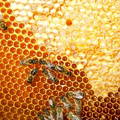
fROM THE FARM TO YOUR TABLE
During each season, a beehive typically produces an excess of honey beyond what the colony requires for its survival. Beekeepers can then harvest this surplus honey. The process involves carefully removing the honeycomb frames from the hive and delicately scraping off the wax caps that the bees have made to seal each cell filled with honey.
To separate the honey from the honeycomb, beekeepers employ a method known as honey extraction. The frames are placed in a specialized device called a honey extractor, which uses centrifugal force to spin the frames rapidly.
Trending Articles
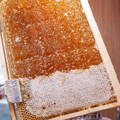
The spinning motion causes the honey to be flung out of the honeycomb and collect on the inner walls of the extraction barrel. As gravity causes it to pool in the bottom of the extraction barrel, the honey can be tapped.
Honey extraction can be done manually, where the beekeeper uses hand-cranked extractors, or with electrical extractors, which automate the process. The choice of extractor depends on various factors such as the scale of the beekeeping operation and the beekeeper's preferences.
Gypsy Shoals Farm offers honey extraction services for local beekeepers who may not want to invest in the equipment immediately. Services can be scheduled full-service or do-it-yourself and are priced accordingly. Reserve your time early in the season because they book up fast.
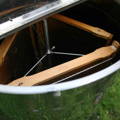
After honey extraction, the next step involves straining the honey to remove any residual wax and small particles. It's essential to differentiate between straining and filtering. Straining involves removing large particles such as wax cappings from the honey while allowing beneficial components like pollen to remain in the honey.
On the other hand, filtering employs finer filters that remove most of the pollen and other elements, which some commercial honey producers might choose to achieve a smoother appearance but, in turn, sacrifice some of the health benefits associated with honey.
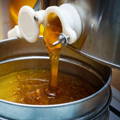
Gypsy Shoals Farm honey is not filtered so it retains all of the pure and natural health benefits that you desire when purchasing honey. This all-natural process delivers the most authentic flavor in a sweet and wholesome treat right to your table.
Beekeepers, with their knowledge and experience, play a crucial role in the honey-making process. They carefully manage the beehives, ensuring the health and well-being of the bees, and providing them with suitable environments for foraging. Beekeepers also strategically position the hives in areas with abundant and diverse flowering plants, allowing the bees to access a wide variety of nectar sources.
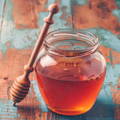
The journey of honey from flower to table is an amazing partnership between the flower, the honeybee and the beekeeper. From the alluring beauty of blooming flowers to the meticulous work of the honeybee and the skillful care of the beekeeper, each step in the process contributes to the creation of one of nature's finest delicacies.
Trending Products
Copyright©2023 All rights reserved. We love to have you share our article as long as you include a direct link to this page.This article or any portion thereof , including all images, may not be reproduced or used in any manner whatsoever without the express written permission of Gypsy Shoals Farm.

